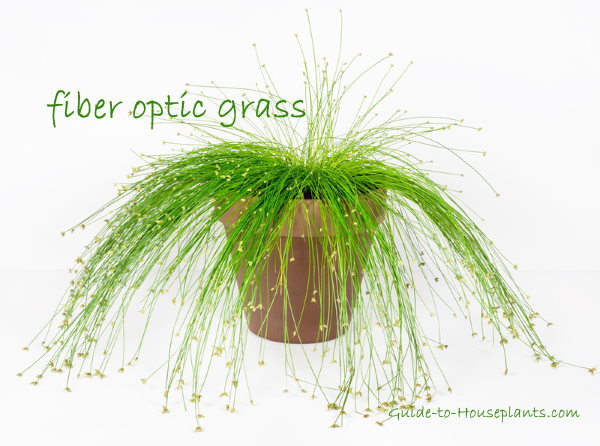Is Live Wire Fiber Optic Grass Animal Safe
Fiber Optic Grass
Botanical Name: Isolepis cernua aka Scirpus cernuus
Cobweb Optic Grass is a fountain-like ornamental grass-like sedge with small, silvery whiteflowers at the tips. Its resemblance to cobweb optic wire lends its common names, including Live Wire Grass.
If yous like unusual indoor plants, you'll desire to add together this ornamental sedge to your collection. Information technology's a fun establish to have around.
 Cobweb Optic Grass grows well in a container indoors or on the patio. Photograph © Lawcain
Cobweb Optic Grass grows well in a container indoors or on the patio. Photograph © Lawcain
Growing in a clumping mound, Isolepis cernua spills over the sides of a container as it grows, making it ideal for a tall planter or even a hanging pot. Eye-catching on its own, this decorative grass-like sedge as well adds texture among a brandish of foliage and flowering plants.
Yous'll find fiber optic grassfor sale in garden centers and online nurseries in spring and summer. Plants are cheap, and y'all can likewise buy seeds. Sowing seeds is easy (see Propagation below).
Is Cobweb Optic Grass poisonous? Yes, both the plant and seeds are toxic if eaten. Keep it away from children and pets if in that location is whatever chance they may play with or ingest them. Isolepis cernua can also cause skin irritation so you may desire to wear gloves when handling it.
Water generously. Don't permit the soil to dry out. Foliage will plow xanthous then brownish when it gets too dry. Water thoroughly and oft to keep the soil at least evenly moist at all times. Cobweb Optic Grass is native to marsh areas, and so it doesn't mind soggy soil.
Repot in spring, moving upwards to a container 1 size larger every 2-3 years, or when it becomes crowded. Spring is besides a adept fourth dimension to dissever the constitute, if you lot want.
Perennial and evergreen, this showy sedge is an easy-intendance house plant. Continue it warm and moist, give it sunlight, and you can wait blooms from bound through fall.
Fiber Optic Grass Care Tips

Origin: Southern Europe and Northern Africa
Height: Upward to 1 ft (30 cm)
Lite: Bright light to full sun
Water: Keep the soil moist or wet at all times. Constantly moist soil is needed to keep I. cernua healthy and thriving. Native to marshlands, this is i plant you can't overwater.
Humidity: Moderate room (around twoscore% relative humidity).
Temperature: Average to warm room temperatures (65-eighty°F/18-27°C) year-round. If you lot put this tender ornamental out on the patio for the summer, it tin can take the heat, but bring it back indoors when the temperature drops. It won't tolerate frost.
Soil: Peat moss-based mix, such as African violet potting mix.
Fertilizer: Feed monthly spring through fall with a balanced water-soluble fertilizer diluted by one-half.
Propagation: Sow seed in jump, barely covering the seeds. Keep the soil warm (around 70°F/21°C) and constantly moist. Mature plants can be divided and potted separately.
- Dwelling house ›
- Houseplants A-Z
Source: https://www.guide-to-houseplants.com/fiber-optic-grass.html
Posted by: thomasexprooking.blogspot.com

0 Response to "Is Live Wire Fiber Optic Grass Animal Safe"
Post a Comment